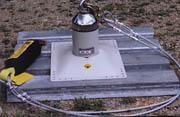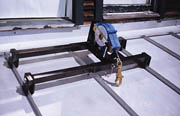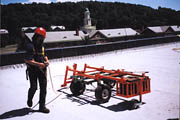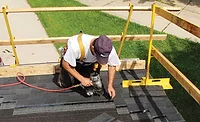Roof Anchor Points
Last month I outlined some of the basic issues surrounding personal fall arrest systems and roof anchor points. This month I will review four innovative anchor point devices. It is not my intention to compare these four units; they are all designed for different purposes on different roof styles, job conditions and materials. Rather, my goal is to provide some specifications, manufacturer’s benefits and features, as well as some of my own evaluations of their installation and functions.

Mansafe Anchor for Metal Pitched Roofing
Manufacturer: Latchways Fall Arrest SystemsU.S. Distributor:
Hy-Safe Technology, Union Grove, Wis.
800.642.0775
www.hysafetech.com
Unit list cost: $360
Cylinder size: 4-inch diameter by 8-inch height (base plate 12 inches by 14 inches)
Weight: approximately 10 pounds
Features
- Lightweight and easy to install, the device is top-fastening so the primary function of the building is unaffected during installation.
- The product is a removable/reuseable swiveling roof anchor that may be designed for either: a mono-point anchorage system for either a 6-foot shock-absorber lanyard or a self-retracting lanyard; or, a multiple-point anchorage system (custom designed by Hy-Safe according to site-specific criteria) in series for Roto-latch horizontal 318-ss marine-grade wire-rope lifeline system with swaggered ends and adjustable turnbuckle.
- The device may be installed on flat (or 1:12 max) roofs because the energy coil is primarily designed for horizontal loading forces.
- The unobtrusive, low-profile design does not interfere with roof design or aesthetics. It may be powder-coated and color-matched to the roof.
- The anchor attaches to the metal-roof deck panel with weather-tight stitching screws and self-adhesive buffer pads, maintaining a 3-foot minimum clearance from any roof edge.
- The integrity of roof is unaffected; avoiding weather-proofing problems and eliminating cold bridging.
- The anchor device may be located anywhere on the roof deck and doesn’t need to be attached to a rafter, purlin or other structure.
- In the event of a fall, the integral energy-absorbing coil deploys inside of the stainless steel housing, limiting impact loads to approximately 2,250 pounds within the tensile strength of the stitching screws, leaving the roof panel intact.
- ManSafe CFPA can be designed in both fall arrest and fall restraint systems. It is approved by all major roofing manufacturers.
- It meets or exceeds all OSHA/ANSI standards.
- Training and evaluating roofers in safe work practices is an essential part of implementing any employer’s written fall protection program, especially concerning the practical uses and limitation of any manufacturer’s anchor device. Hy-Safe Technology provides turnkey services including assessment, design, engineering, fabrication, installation, testing, certification and employee training.
Device Evaluation
(1=excellent, 2=good, 3=fair, 4=poor)
Affordability (1): All fall arrest system components are typically expensive, primarily for liability reasons. Most comparable anchor devices start at or above this item’s list price.
Installation (1): Once the location is selected and the installer is properly equipped and protected from interim falls, installing this lightweight device takes usually less than five minutes per anchor.
Versatility (2): For maximum simplicity and ease of installation, this unit is best utilized as a monopoint anchor. Whereas multiple anchors deployed in a horizontal lifeline system increase their versatility, these applications typically require the qualified person to design and implement with the manufacturer’s appropriate safety factor.
Durability (2): While designed as a single-fall use, to be taken out-of-service after any fall incident, this unit has an obvious limited lifetime. I have not had it in regular roof duty very long, so I cannot report on its long-term durability if used as a multi-installation anchor. A permanent installation may increase its overall durability.
Overall rating (1): This anchoring device has found a prominent place in my roofing PFAS inventory. It has also proved useful for many ironworker applications during multi-tiered B- and Q-deck installations.

Swiveling Roof Anchor with 30-foot Self-retracting Lanyard
Manufacturer:DBI Sala, Redwing, Minn.
800.328.6146
www.salagroup.com
Unit list cost:
Swiveling Roof Anchor (#3505694) (without SRL): $785
30-inch Ultra-Lok® SRL (#3504431) (without anchor): $665
Size:
Swiveling Roof Anchor: 2 feet 2 inches by 3 feet (footprint); 2 foot height
30-inch Ultra-Lok SRL: 10 inches by 8 inches
Weight:
Swiveling Roof Anchor: 19 pounds
30-inch Ultra-Lok SRL: 10 pounds
Total Weight: 29 pounds
Features
- When testing this product, we made roof access utilizing a vertical ladder through a 30-inch-by-30-inch curbed roof hatch. The best means of a single worker to transport this unit was to rope-haul the SRL and swiveling roof anchor up to the roof after access. Carrying anything that could potentially cause the worker to lose three-point contact or fall off the ladder is a violation of OSHA’s Part 1926 Subpart X. The device has hinged legs and tie-down straps that could suddenly swing open or closed and catch on the ladder or obstructions.
- The unit was secured to the roof deck with the 1/4-inch-by-2 1/2-inch lag bolts provided, in just a few minutes after the rafters and purlins were finally located from below. Dimensioning the structure without damaging the finished roof membrane was difficult because the warehouse roof was 20 feet above the floor below. The 30-foot radius provided by the retractable aircraft cable proved adequate for inspecting the 2:12-pitched roof for storm damage and possible membrane failure.
- This device is a removable/reuseable swiveling roof anchor designed to anchor SRL.
- It is completed with the 30-foot Ultra-Lok SRL fastened to the frame with two bolts with safety nuts.
- The product is capable of rotating 360 degrees, giving workers maximum freedom of movement.
- The anchor is fastened to the roof deck with 24 16d nails or 12 1/4-inch-by-2 1/2-inch lag screws into sheathing and joist/rafter.
- The device can be used on flat to 12:12-pitched roofs.
- It is also available with 50-foot SRL.
- Use of multiple swivel anchors and two SRLs will extend the roofer’s ability to maintain 100-percent tie-off while safely moving across a large area by “leapfrogging” the SRLs on the swivel-roof anchors.
- All components are capable of 5,000-pounds-minumum breaking strength.
- The product meets or exceeds all OSHA/ANSI standards.
Device Evaluation
(1=excellent, 2=good, 3=fair, 4=poor)
Affordability (3): Although the combined price of a single anchor device with a 30-foot SRL is close to the $1,500 range, the small contractor may still find this unit attractive. The fact that the anchor may be used under many roof and deck conditions and the SRL may be conveniently used in many other fall protection applications helps make the utility of the unit defray the cost.
Installation (2): The unit’s weight and four flexible swing legs make this product difficult to handle. Steep-pitch roofs and slippery conditions may pose a difficult challenge to maneuver while carrying the equipment. As with all PFAS, any “first-man-up” situation, fall protection training, safe work practices and site precautions should be taken while installing any permanent or temporary anchor. Some attention to detail is required by the installer, since all fasteners must be carefully attached (and confirmed) to either rafters or purlins or other adequate structure.
Durability (1): This unit is designed exclusively for construction phase protection. The manufacturer’s line of this type of equipment is extensive and time tested. Although this unit has rugged components and simple, trouble-free design, weather and re-installation abuse may cause damage. With all roof fall protection anchors, regular pre-shift inspection of the unit and its installation is recommended to detect any defects or damages that affect the unit’s structural integrity and worker safety.
Versatility (1): This is primarily a ridge anchor, but with legs adjustable down to a flat surface with adequate sub structure, it could certainly be applied to any other flat deck with leading edge fall hazards. While the 360-degree rotation capability and 30-foot retractable lifeline gives the attached worker a significant work radius, pre-use training and on-site caution should be taken on irregular shaped roofs and projects where workers may become entangled with obstructions or other workers.
Overall rating (2): This anchoring device has found a prominent place in my PFAS inventory, as well as my fall protection training curriculum, because it may be installed and reinstalled without substantially affecting the finished roof’s integrity.

Standing Seam Roof Anchor with 30-foot SRL
Manufacturer:DBI/SALA
Red Wing, Minn.
800.328.6146
www.salagroup.com
Unit list cost:
Standing Seam Anchor (#2103675): $325 (without SRL)
30-foot Ultra-Lok SRL (#3504431): $665 (without anchor)
Size:
Standing Seam Anchor: 1 foot 3 inches by 2 feet (adjustable to 3-foot footprint)
30-foot Ultra-Lok SRL: 10 inches by 8 inches
Weight:
Standing Seam Anchor: 45 pounds
30-foot Ultra Lok SRL: 10 pounds
Total weight: 55 pounds
Features:
- This product is a removable/reusable standing-seam roof anchor designed to anchor SRL (not intended for architectural standing seam roof panels).
- It is completed with a 30-foot Ultra-Lok SRL, limiting fall-arrest force to 1,800 pounds maximum for one roofer (310 pounds max) attached.
- The device is capable of rotating 360 degrees, giving workers maximum freedom of movement.
- The anchor is fastened to vertical metal seams with four screw clamps (at 75 feet/pounds torque), which adjust to 24- to 26-inch seam widths. Hook clamps must be seated underneath the folded roof seam.
- The equipment is adaptable to low-pitch (4:12) up to 12:12-pitch roofs.
- The device is reusable/relocatable and designed to be used in multiple anchor systems.
- All components are capable of 5,000-pounds minimum breaking strength.
Device Evaluation
(1=excellent, 2=good, 3=fair, 4=poor)
Affordability (1): All fall arrest system components are typically expensive, primarily for liability reasons. Most comparable anchor devices start at or above this item’s list price.
Installation (2): Like the Swiveling Roof Anchor, this unit has a considerable weight and may require caution during installation, especially on high-pitch metal roofs. Once in place, it was installed in less than five minutes. The black-steel base frame gets quite hot on an August afternoon and can be difficult to handle without gloves. This would be an excellent application for carbon-fiber composite, which is lighter, stronger and less prone to solar heating.
Durability (1): Very sturdy construction. Simple, rugged framework and bolts. Nothing to get easily damaged in storage or transportation.
Versatility (3): While it is adjustable for various seam widths, this anchor is specifically designed for standing-seam roofs and has no other approved applications. Any attempt to modify this anchor for use on other roofs would void the warranty and be extremely hazardous to workers.
Overall Rating (2): While extremely durable and reusable, the weight of this unit makes it difficult to handle on steep pitches. However, if you are a metal roof specialist, this unit may prove to be very desirable.

PR 600 Mobile Fall Protection System
Manufacturer:Protective Roofing Products
Stone Creek, Ontario, Canada
800.560.3093
www.prplimited.com
Unit list cost: $1,075 (plus shipping), not including the utility trailer
Assembled size on utility cart: approximately 9 feet by 4 feet by 30 inches (height)
Weight:
PR 600: 250 pounds
Garlock utility trailer: 160 pounds
Counter weights: 500 pounds
Total weight: 910 pounds
I observed the installation and use of this mobile anchor device by the invitation of Nathan Daniel, the safety director for Hartford Roofing Co., Glastonbury, Conn. The occasion was a 450-square, cold-applied selvege edge-rolled roofing project on the campus of the University of Massachusetts. Although roof edges were parapetted to 32 inches, edge work outside the warning lines could be easily completed using this unit without a safety monitor.
As explained by Ted Palmer, owner and president of Protective Roofing, this unit solves all of the flat-roof anchor requirements. The job foreman and his lead roofer assembled the PR600 without previous experience, using the manufacturer’s written instructions (an assembly video, provided with each purchase, was not viewed). It took only 10 minutes to complete, with only one installation error.
The receiver sleeves on both sides of the base frame are designed to accept either the counterweight arms or the pivot arms. The pivot arms, however, are designed to be fastened into the base frame, using horizontal locking pins located on only one side of the frame. If not detected by the roofer, reverse assembly error may have resulted in the release of the critical pivot arms in the event of a fall. Once corrected, however, the unit proved extremely stable and dependable.
The manufacturer has gone to great effort to build an excess of 2x safety factor in all of its designs, including an independent testing agency and worst-case-scenario drop tests (for example, ice-covered, frozen roof decks; drop tests parallel to trailer tires; excess weights, etc.). After all, as designed, the pivot arms remain 1/2-inch above the finish and do not penetrate the roof materials until a fall is initiated. Even though it is not “securely fastened to a suitable structure,” as stated in the Fall Protection standard, OSHA currently considers the use of this device part of an adequate personal fall arrest system to be in compliance with Subpart M. The simple design and thorough testing assured me that this unit is truly a worthy and dependable anchoring device on decks up to 0.5:12 pitch.
Features
Device Evaluation
(1=excellent, 2=good, 3=fair, 4=poor)
Affordability (3): Though you definitely get what you pay for, the four-digit price tag can certainly limit purchase for many small, low-budget roofers. Installation (2): Once the major components (including counter-weights provided by the contractor) of the PR600 and roof trailer are on the roof deck, assembly is pretty easy. Pieces slide into receivers and lock with twist bolts or pins with cotters. The unit is adaptable to anchor to both finish roof surfaces and also wood or steel decks under construction. Without and elevator and/or stairs, a crane or material hoist would facilitate the lifting of the significant weights involved, reducing set-up labor but adding to equipment cost.
Durability (1): This is a rugged unit, with no sensitive or delicate part to break, adjust or even grease. Any component may be replaced if necessary. The adjustable bed fits various-sized roof trailers. General inspection and regular maintenance should provide years of trouble-free use.
Versatility (1): Under the manufacturers specifications and use parameters, the PR 600 certainly lives up to its title as a mobile fall protection system, but its maximum capacity is limited to two roofers (310 pounds max) in fall arrest mode and one in fall restraint mode. The unit must remain 15-feet minimum from leading edges and workers must be on the pivot arm side of the trailer and remain within 25 degrees of perpendicular to the utility cart. If the roofers are adequately trained and equipped to use this device, there are few flat roof anchors that can be considered more useful and mobile.
Overall Rating (2): If list cost was not a factor in today’s market, this anchor device would rate a “1.” Consequently, the small-to-intermediate-sized roofing contractor may not have the bid budget necessary for the initial cash outlay. However, as an overhead line item, spread out over many productive years, it may prove more affordable.
Summary
While most employers trust that their field managers are experienced and capable of making safety system decisions on a job-specific basis, your written fall protection program should contain specific procedures to be followed to select anchor points on various roofs. Your crews would subsequently be trained in these updated procedures. Whenever your job supervisor or another qualified person is assigned the responsibility to select and rig proper PFAS anchor points for your crew, you must be absolutely confident the following five areas are addressed:A thorough site inspection log and technical load calculation has been made and documented on the strength of the roof support structure.
Adequate safety factors have been considered for every component of the PFAS.
Your experienced workers go to annual refresher training courses and are currently evaluated; and your new hires have been comprehensively trained in fall protection and assigned an experienced co-worker as a fall protection partner.
A system is in place to quickly tag any fall protection equipment “out of service” and then replace it should the qualified person suspect that its integrity has been affected.
Site inspections are conducted, logged and signed by the qualified person pre-shift and regularly during the shift to ensure that there is no damage to the equipment or defects in the PFAS support structure.
In your weekly tooolbox safety meetings, emphasize the interdependence of the different components of the fall protection systems, including the roofer. Make certain that the “human factor” is always considered. Discourage employees from taking short cuts for the sake of completion time and budget. The root cause of one third of all construction fatalities is falls from heights above 6 feet. Encourage all roofers to take the time necessary to design, build, inspect and re-inspect every part of their fall protection system from the buckles on their harness down to the purlins to which their anchors are fastened. Just 15 crew-minutes for housekeeping and inspection morning and afternoon can prevent a catastrophe and possible fall fatality.
Looking for a reprint of this article?
From high-res PDFs to custom plaques, order your copy today!



